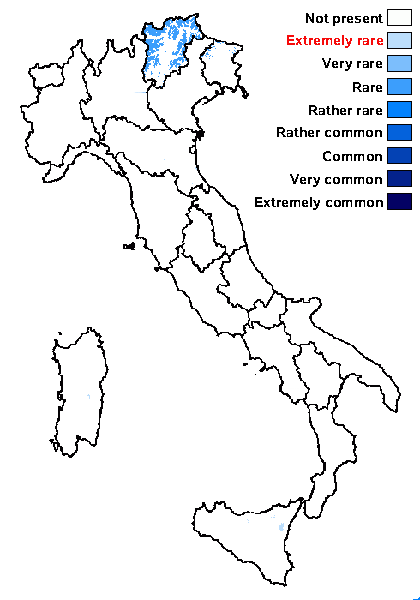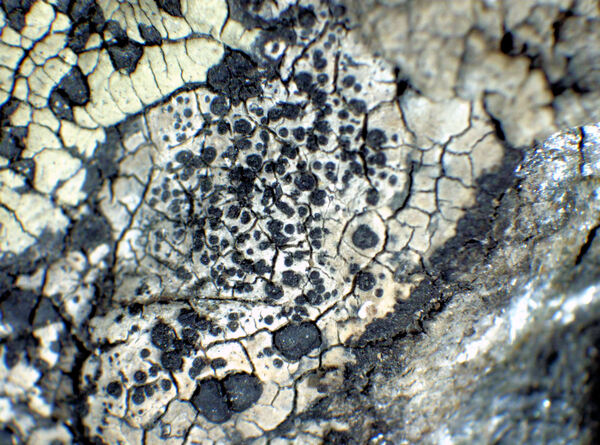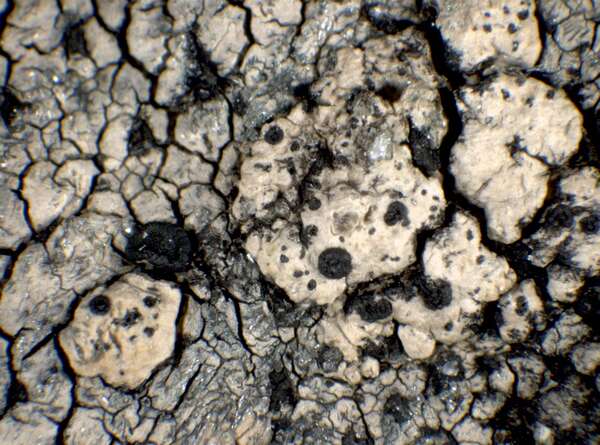Cecidonia umbonella (Nyl.) Triebel & Rambold
Nova Hedwigia, 47: 284, 1988. Basionym: Lecidea umbonella Nyl. - Flora, 49: 372, 1866.
Synonyms:
Distribution: N - Frl (Tretiach & Hafellner 2000, Brackel 2016), TAA (Hertel & Schuhwerk 2010, Brackel 2016), Emil (Tretiach & al. 2008, Brackel 2016). C - Sar (Brackel 2016). S - Si (Brackel 2016).
Description: Thallus inapparent, growing inside the thalli of epilithic Lecidea-species, especially Lecidea lapicida, inducing the formation of white, gall-like, 4-6 mm wide, 0.3-0.4 mm high swellings. Medulla of the galls I+ blue. Apothecia lecideine, 0.3-0.5(-0.6) mm across, with an umbonate, black disc and a raised, brown-black, often cracked proper margin. Proper exciple of irregular chains of swollen cells, carbonaceous black in outer part, paler brown within, 60-120 μm thick laterally; epithecium brown to olive-brown; hymenium colourless or most often with brown vertical streaks, 70-120 μm high; paraphyses coherent, branched and anastomosing, 1.2-2 μm thick at mid-level, the apical cells 2-3(-3.5) μm wide; hypothecium pale to dark brown, 40-150 μm high. Asci 8-spored, subcylindrical-clavate, the apex thickened, with a K/I+ pale blue apical dome usually with a distinct I+ blue, shallow subapical ring, Lecidea-type. Ascospores 1-celled, hyaline, broadly ellipsoid, (10-)11-15(-16) x 6-8(-10) μm, the wall 2-layered, up to 0.8 μm thick. Pycnidia black, immersed. Conidia simple, hyaline, bacilliform, 5-9 μm long (not clear whether these are the conidia of the host lichen). Photobiont absent (the galls have a chlorococcoid photobiont). Spot tests: all negative, but the galls often react K+ yellow turning red, C-, KC-, P+ yellow. Chemistry: without lichen substances, or norstictic acid from the host.
Note: a lichenicolous fungus found on exposed siliceous rocks near and above treeline, growing on the thalli of Lecidea lapicida s.lat., certainly occurring throughout the Alps.
Growth form: Lichenicolous fungus
Substrata: rocks
Reproductive strategy: mainly sexual
paras Lecidea lapicida s.lat.
Commonnes-rarity: (info)
Alpine belt: rare
Subalpine belt: rare
Oromediterranean belt: extremely rare
Montane belt: absent
Submediterranean belt: absent
Padanian area: absent
Humid submediterranean belt: absent
Humid mediterranean belt: absent
Dry mediterranean belt: absent

Predictive model
Herbarium samples
Growth form: Lichenicolous fungus
Substrata: rocks
Reproductive strategy: mainly sexual
paras Lecidea lapicida s.lat.
Commonnes-rarity: (info)
Alpine belt: rare
Subalpine belt: rare
Oromediterranean belt: extremely rare
Montane belt: absent
Submediterranean belt: absent
Padanian area: absent
Humid submediterranean belt: absent
Humid mediterranean belt: absent
Dry mediterranean belt: absent

Predictive model
| Herbarium samples |
 INDEX FUNGORUM
INDEX FUNGORUM
 GBIF
GBIF
 DOLICHENS
DOLICHENS




